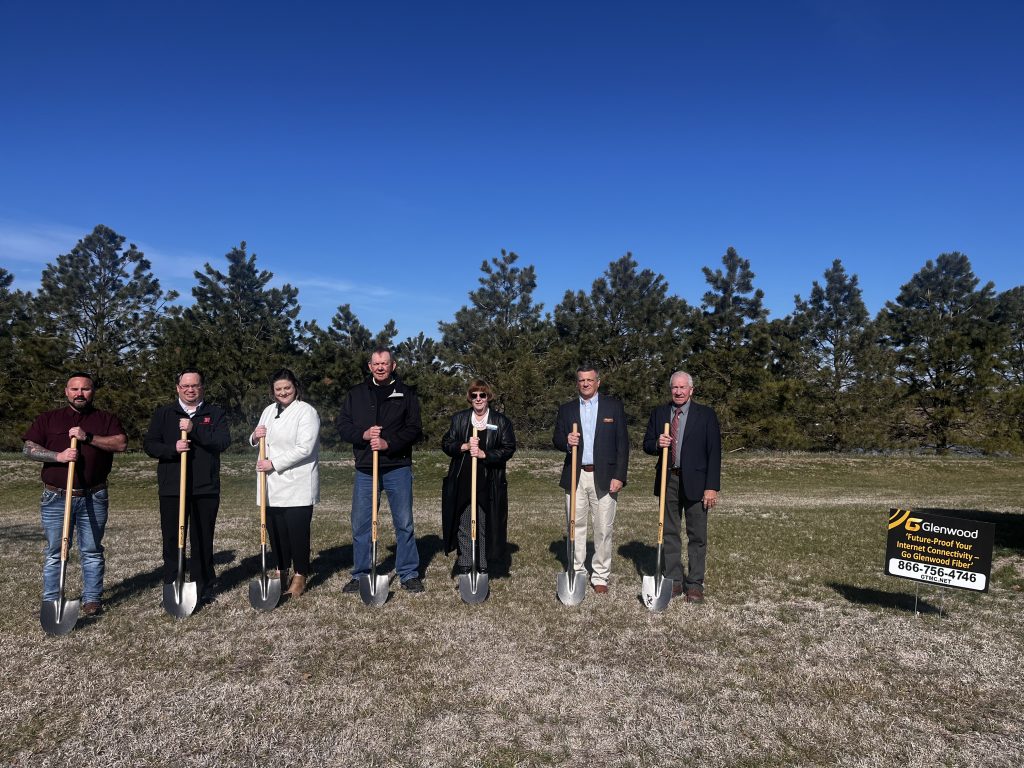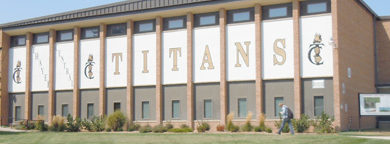Digital building begins on Road P

Breaking ground for Glenwood’s rural broadband project in Thayer County March 30 was (From left to right) Drake Turner of Alpha Construction; Jason Tuller, Rural Prosperity Nebraska Extension Educator; Carley Bruning, executive director of Thayer County Economic Development Alliance; Thayer County Commissioner Dean Krueger; Kelly Gewecke of the Nebraska Department for Economic Development; Glenwood CEO and General Manager, Stan Rouse; and Nebraska Public Service Commissioner Dan Watermeier.
The digital bridge building in Thayer County has begun as Glenwood Telecommunications held a formal ribbon cutting ceremony March 28 at Randy and Becky Hergott’s property on Road P, where the project will see about 50 miles of underground fiber optic line and eventually serve approximately 54 residents.
“It’s a significant milestone,” Jennifer Reiman, director of business development for Glenwood, said regarding the project’s journey toward a more connected and technologically advanced future for rural Thayer County.
Glenwood was one of the recipients of the Nebraska Broadband Bridge Program for five grant awards, or about $3.4 million to serve Thayer, Fillmore and York counties, and beyond. The total grant award for Thayer is $$1,376,220.37.
Special guests attending the ceremony included county commissioner Dean Krueger; Thayer County Economic Development Alliance Director and Broadband Action Team member Carley Bruning; Rural Prosperity Nebraska Extension Educator and BAT member Jason Tuller; Drake Turner of Alpha Construction that will be working to lay the fiber optic; Dan Watermeier, Nebraska Public Service Commissioner; and Kelly Gewecke from the Nebraska Department of Economic Development.
Stan Rouse, CEO and general manager of Glenwood thanked the guests and said working in conjunction with the county to expand broadband in rural Thayer County began several years ago, and thanked the BAT team and the commissioners.
He added rural broadband accessibility allows residents to work from home, communicate via telehealth and entice young families to stay in the county.
“Glenwood has been very receptive,” Krueger said. “We have to stay competitive.” The county commissioners contributed $300,000 of American Rescue Plan Act funds toward the project. “We had a certain period of time to disperse those funds. We used some at the courthouse and some for broadband. We may end up partnering again with Glenwood on rural broadband.”
“This is taking it to the next level right where people need it. You’re making the difference here and this is what we need all across the state of Nebraska,” Watermeier said.
The broadband branch on Road P will be finished by fall and include some 50 miles of fiber, branching out from an existing line that runs along Highway 81 toward Gilead, Alexandria and Carleton, according to a news release from the University of Nebraska-Lincoln Institute of Agriculture and Natural Resources written by Russell Shaffer of Rural Prosperity Nebraska.
In the release, Tuller called the rural broadband plan “last mile funding.”
“This is for really rural areas,” Tuller said. “If you look at the federal maps, everyone has internet because things like Starlink are available, but it’s expensive and not very fast, so when you get down to it, there are significant portions of the county that don’t really have affordable, reliable service. Our aim was to get farmers, ranchers and families who live in the middle of acres of Nebraska landscape, connected.”
This move has been needed for a long time, Bruning said.
“When we look at rural communities, sometimes people just see houses,” she said. “But I see a spouse who works from home. I see kids that need to do homework. I see a family that would really like to stream Disney+. Nowadays, the internet is infrastructure just like running water.”
The trickiest aspect of approving the project proposal—the news release stated-—was mapping out unserved and underserved residents.
Unserved residents have no access to land-based internet and must rely on satellite service. Underserved residents technically have access to land-based internet even if, as is often the case in rural areas, the technology is antiquated, offering only slow and unreliable access.
“They would bring in a map and say, ‘If we cover this road here, we’ll reach 10 people,’” Tuller said. “But you’re out on country roads with very few people. Our action team would come in and say, ‘If you take this road instead of that road, you’ll still hit almost all of those people, and you’ll pick up five more. Because we knew who lived on those roads, we were kind of the local boots on the ground to help them with that.”
With the funds and construction now in place, Bruning is looking forward to seeing not just what broadband does for residents, but what it means for Thayer County’s future.
“On a lot of our acreages, rural residents have never lived anywhere with high-speed internet,” Bruning said. “So what they have is good enough for them. But with Glenwood working to bring service to those homes, it’s putting that infrastructure in to make the homes more valuable for when the next generation purchases the homes and starts their family there.”


